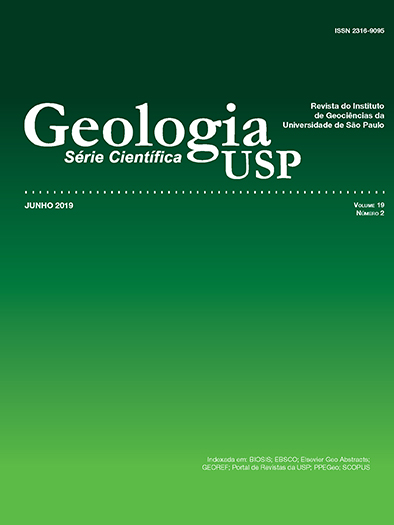Petrology of Sítios Novos Batholith, Sergipano Orogenic System, Borborema Province, NE Brazil
DOI:
https://doi.org/10.11606/issn.2316-9095.v19-152469Keywords:
Monzogranites, Sítios Novos Batholith, PetrologyAbstract
The Sítios Novos Batholith (110 km2) is an NE-SW elongated intrusion, with an age of 631 ± 4 Ma (which agrees with the regional orientation) and is located in the southern part of the Poço Redondo Domain, in the Sergipano Orogenic System. This batholith is constituted by leucocratic monzogranites with equigranular and unequigranular allotriomorphic texture, which occasionally present pegmatitic dikes. Mafic enclaves are rare. The batholith’s southern region is affected by the regional shear zone and the monzogranites developing milonitic and gneissic structures. Oligoclase and albite are the plagioclase present in these granites and the microcline is occasionally perthitic. Biotite is the dominant mafic mineral and its composition indicates affinity with orogenic suites (calcic-alkaline and peraluminous). Zircon, titanite, magnetite, ilmenite, apatite, thorite, allanite and monazite occur as accessory minerals. Bastnaesite and barite often occupy microfractures in these rocks. The monzogranites’ geochemistry shows that they are fractionated rocks (SiO2 > 68%), peraluminous to metaluminous and are allocated in geochemical diagrams in the field of I-type granites. The REE spectra present moderate fractionation (15 < LaN/YbN < 70), with negative anomaly in Eu, indicating plagioclase fractionation. In multielementary diagrams, the samples of this batholith have pronounced valleys in Nb, P, Ba and Ti, and more or less accentuated peaks in Th, Pb and Zr. This geochemical signature is characteristic of orogenic magmas. These monzogranites have as probable source the partial melting of tonalitic crust.
Downloads
Downloads
Published
Issue
Section
License
Authors who publish in this journal shall comply with the following terms:
- Authors keep their copyright and grant to Geologia USP: Série Científica the right of first publication, with the paper under the Creative Commons BY-NC-SA license (summary of the license: https://creativecommons.org/licenses/by-nc-sa/4.0 | full text of the license: https://creativecommons.org/licenses/by-nc-sa/4.0/legalcode) that allows the non-commercial sharing of the paper and granting the proper copyrights of the first publication in this journal.
- Authors are authorized to take additional contracts separately, for non-exclusive distribution of the version of the paper published in this journal (publish in institutional repository or as a book chapter), granting the proper copyrights of first publication in this journal.
- Authors are allowed and encouraged to publish and distribute their paper online (in institutional repositories or their personal page) at any point before or during the editorial process, since this can generate productive changes as well as increase the impact and citation of the published paper (See The effect of Open Access and downloads on citation impact).





